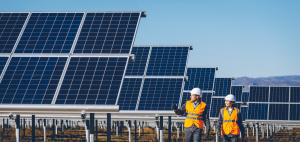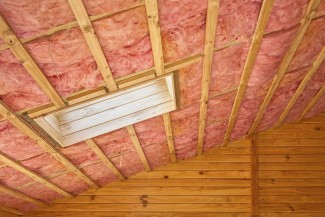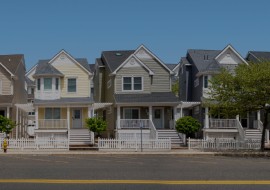Buildings and homes consume approximately 75% of the electricity used in the United States, and they account for 40% of primary energy use and corresponding greenhouse gas emissions. Given the scale of energy and carbon resources dedicated to these buildings and homes, there is a significant opportunity to achieve savings. ACEEE seeks to advance evidence-based clean energy solutions that not only significantly reduce carbon emissions but also advance social equity, maximize the health and well-being of all people, and help ensure a just and inclusive clean energy transition.
Whole-Building Savings
 ACEEE advocates using a whole-building approach to saving energy in new and existing buildings. A whole-building approach considers the building envelope, HVAC system, water-heating system, appliances, and other equipment in the building and uses energy modeling to identify the most cost-effective opportunities for improving efficiency. Federal, state, local, and utility incentives can reduce the upfront cost of many of these upgrades.
ACEEE advocates using a whole-building approach to saving energy in new and existing buildings. A whole-building approach considers the building envelope, HVAC system, water-heating system, appliances, and other equipment in the building and uses energy modeling to identify the most cost-effective opportunities for improving efficiency. Federal, state, local, and utility incentives can reduce the upfront cost of many of these upgrades.
While there are specific considerations for each project, typically the first step is ensuring that the building envelope is well insulated and sealed. A well-designed building envelope will lose (or, in the summer, gain) heat much more slowly, resulting in less need to run the HVAC system. This saves money on energy costs and can allow the homeowner to downsize the HVAC system. An efficient water-heating system can be designed with efficient equipment as well as an efficient piping layout and fixtures to reduce water use. Similarly, efficient appliances can save both energy and water. It is also important to consider the efficiency of other equipment in the building (e.g., computers, servers, gym equipment, and manufacturing equipment) as well as ways to operate it more efficiently. Finally, reducing the energy use of a whole building then allows for a smaller renewable energy system, such as rooftop solar, to meet the building’s energy needs.
Building Envelope
 A building envelope refers to the parts of a building—including external walls, windows, skylights, doors, and floors—that act as barriers to the outside world. A good building envelope saves energy by preventing the transfer of heat in or out of the building. High-quality envelope components, like thick insulation or high-efficiency windows, help maintain comfortable indoor temperatures, while sufficient sealing of gaps and openings in the building envelope, like sealing around windows, prevents air infiltration (i.e., leaks).
A building envelope refers to the parts of a building—including external walls, windows, skylights, doors, and floors—that act as barriers to the outside world. A good building envelope saves energy by preventing the transfer of heat in or out of the building. High-quality envelope components, like thick insulation or high-efficiency windows, help maintain comfortable indoor temperatures, while sufficient sealing of gaps and openings in the building envelope, like sealing around windows, prevents air infiltration (i.e., leaks).
By preventing drafts and uneven temperatures, a high-performing building envelope improves the comfort of its occupants, and by preventing potential problems like mold, mildew, fungal growth, and dust mites, protects their health. Because high-quality envelopes will also help buildings maintain their temperature during power outages, they are a powerful way to improve resilience, especially as the climate changes. ACEEE research, policies, and programs can be found in the links below and to the right. For specific efficiency tips and guidance on residential building envelope, click here.
Heating, Ventilation, and Air-Conditioning
 HVAC systems are made up of the heating, air-conditioning, and ventilation systems in a commercial building or residential home. These mechanical systems provide thermal comfort and air quality in indoor spaces. Ventilation is the portion of the system that can ensure indoor air quality, though it is important that it is designed well because it can also use a significant amount of energy.
HVAC systems are made up of the heating, air-conditioning, and ventilation systems in a commercial building or residential home. These mechanical systems provide thermal comfort and air quality in indoor spaces. Ventilation is the portion of the system that can ensure indoor air quality, though it is important that it is designed well because it can also use a significant amount of energy.
Types of HVAC systems include air conditioners, heat pumps, furnaces, boilers, rooftop units, chillers, and packaged systems. A building’s HVAC system encompasses components such as ductwork and air handlers, which are essential to system performance. Once a building’s envelope is designed well, it is important to consider a high-performing HVAC system composed of efficient equipment that is also right sized for the use and building type. For specific efficiency tips and guidance on residential HVAC, click here.
Lighting
 In the residential homes sector, lighting is used indoors and out to provide ambient light and meet task-specific lighting needs, for decorative purposes, and to provide security. Commercial lighting applications are more varied and include indoor ambient, task, and decorative lighting, street and area lighting, traffic signals, and sign and billboard lighting, among others.
In the residential homes sector, lighting is used indoors and out to provide ambient light and meet task-specific lighting needs, for decorative purposes, and to provide security. Commercial lighting applications are more varied and include indoor ambient, task, and decorative lighting, street and area lighting, traffic signals, and sign and billboard lighting, among others.
LED lighting is now a well-established option for energy-efficient residential lighting. These lights provide high-performance, energy-efficient alternatives to consumers as other, less efficient lighting types are phased out of the market. In the commercial sector, LEDs are increasingly replacing fluorescent and HID (high-intensity discharge) systems to offer energy savings in a broad range of products for commercial applications. For specific efficiency tips and guidance on residential lighting, click here.
Equiment
Consumer Electronics
 Consumer electronics include electronics used for entertainment, office equipment, or telecommunication. As the number of these electronics continues to increase, so too has the energy use in this sector. Standby power (power that the electronic device is using while not performing its main function) is one of the main areas targeted for efficiency improvements, and significant gains have been made to reduce standby power in most product types. As standby power decreases and people spend more time using electronics, greater attention is being directed toward reducing “active mode” energy use. For specific efficiency tips and guidance on the consumer electronics, click here.
Consumer electronics include electronics used for entertainment, office equipment, or telecommunication. As the number of these electronics continues to increase, so too has the energy use in this sector. Standby power (power that the electronic device is using while not performing its main function) is one of the main areas targeted for efficiency improvements, and significant gains have been made to reduce standby power in most product types. As standby power decreases and people spend more time using electronics, greater attention is being directed toward reducing “active mode” energy use. For specific efficiency tips and guidance on the consumer electronics, click here.
Elevators
 Elevator energy consumption in North American office buildings is generally considered to be about 5% of building electricity use (for buildings with central air-conditioning). In general, hydraulic elevators used in relatively low-rise buildings are much less efficient than the traction elevators used in mid- to high-rise buildings. Elevator energy use is not covered in common building codes. New technologies, including optimized software packages, could reduce energy use in elevators by 30%–40%.
Elevator energy consumption in North American office buildings is generally considered to be about 5% of building electricity use (for buildings with central air-conditioning). In general, hydraulic elevators used in relatively low-rise buildings are much less efficient than the traction elevators used in mid- to high-rise buildings. Elevator energy use is not covered in common building codes. New technologies, including optimized software packages, could reduce energy use in elevators by 30%–40%.
Office Equipment
 Office equipment consumes 10% of total commercial electric energy use, and this percentage is expected to continue to rise. By choosing energy-efficient equipment (with an ENERGY STAR® label), purchasers can save a substantial amount on their office equipment electricity bill.
Office equipment consumes 10% of total commercial electric energy use, and this percentage is expected to continue to rise. By choosing energy-efficient equipment (with an ENERGY STAR® label), purchasers can save a substantial amount on their office equipment electricity bill.
Packaged Refrigeration
 Refrigeration systems account for about 15% of electricity use in the commercial sector. About two-thirds of this is consumed by "packaged" refrigeration systems, which are factory-built units. Commercial refrigerators and freezers, ice makers, water coolers, and beverage vending machines generally incorporate both the refrigeration system and the refrigerated compartment in a single package. Small walk-in coolers and ice makers may be self-contained "packaged" systems or may use a remote condenser, like residential central air conditioners. Several of these systems are found in many common building types.
Refrigeration systems account for about 15% of electricity use in the commercial sector. About two-thirds of this is consumed by "packaged" refrigeration systems, which are factory-built units. Commercial refrigerators and freezers, ice makers, water coolers, and beverage vending machines generally incorporate both the refrigeration system and the refrigerated compartment in a single package. Small walk-in coolers and ice makers may be self-contained "packaged" systems or may use a remote condenser, like residential central air conditioners. Several of these systems are found in many common building types.
Renewable Energy or Onsight Storage
 Getting a building to net-zero energy requires making it very energy efficient, then adding renewables (often solar panels). There are often federal, state, local, and utility incentives for installing renewables that assist to reduce the first cost. Combining renewables with onsite battery storage for any excess energy can enhance resiliency by making power available when the grid goes out. These systems can also reduce demand costs for commercial buildings, depending on how the system is controlled and configured.
Getting a building to net-zero energy requires making it very energy efficient, then adding renewables (often solar panels). There are often federal, state, local, and utility incentives for installing renewables that assist to reduce the first cost. Combining renewables with onsite battery storage for any excess energy can enhance resiliency by making power available when the grid goes out. These systems can also reduce demand costs for commercial buildings, depending on how the system is controlled and configured.
Energy Audits
 An energy audit is a thorough accounting of the energy use of an existing building. Also known as energy assessments, audits are a powerful way to improve the energy efficiency and comfort of a home, business, or industrial plant. Because every buildings and industry is unique, energy audits help identify and prioritize specific areas for efficiency improvement. In the residential and commercial sectors, energy audits target the building as a whole and are therefore an avenue for maximizing energy savings. In the industrial sector, audits are often comprehensive but may focus on specific energy-intensive processes. These energy savings, reduced utility bills, and investments in our housing and building stock help address climate change concerns, save money, and create jobs.
An energy audit is a thorough accounting of the energy use of an existing building. Also known as energy assessments, audits are a powerful way to improve the energy efficiency and comfort of a home, business, or industrial plant. Because every buildings and industry is unique, energy audits help identify and prioritize specific areas for efficiency improvement. In the residential and commercial sectors, energy audits target the building as a whole and are therefore an avenue for maximizing energy savings. In the industrial sector, audits are often comprehensive but may focus on specific energy-intensive processes. These energy savings, reduced utility bills, and investments in our housing and building stock help address climate change concerns, save money, and create jobs.
ACEEE is involved with assessing the effectiveness of different types of energy audits (including comprehensive audits, diagnostic audits, remote audits, and information-only audits). We are also involved in crafting weatherization and retrofit language in federal legislative efforts.
Learn More:
- Better Buildings: A DOE initiative, Better Buildings is designed to accelerate investment in and share best practices related to strengthening energy efficiency in homes, commercial buildings, and industrial plants.
- DOE Building Technology Office: Develops, demonstrates, and accelerates the adoption of cost-effective technologies, techniques, tools, and services that enable high-performing, energy-efficient, and demand-flexible buildings and homes
- ENERGY STAR for Commercial Buildings: A voluntary program for benchmarking, saving energy, and building certification that delivers environmental benefits and financial value
- ENERGY STAR Save at Home: A tool for saving energy with ENERGY STAR to see how your simple actions can make a big difference
- SmarterHouse: An online guide by ACEEE to energy savings in the home. It includes measures homeowners can take to tighten the building envelope as well energy-saving advice on appliances, heating equipment, air-conditioning, lighting, and electronics.
- Federal Energy Efficiency Tax Incentives: A summary of the available federal tax incentives for homes





